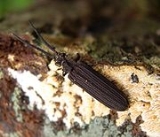
Archostemata
Encyclopedia
Archostemata is the smallest suborder of beetle
s, consisting of fewer than fifty known species organized into five families. Archostemata is an ancient lineage with a number of primitive characteristics. They are similar in morphology to the first beetles, which appear in the fossil record approximately 250 million years ago. Antennae
filiform
or moniliform. This suborder also contains the only paedogenic beetles, Micromalthus debilis.
These beetles are considered rare. Fossil deposits from the Permian
suggest that Archostemata were once much more common and dispersed over a wide portion of the globe, and the species that remain are but scattered vestiges of their former population. There are today five families worldwide (Crowsoniellidae
, Cupedidae, Jurodidae
, Micromalthidae, and Ommatidae
), with only two (Cupedidae and Micromalthidae) occurring in North America.
Beetle
Coleoptera is an order of insects commonly called beetles. The word "coleoptera" is from the Greek , koleos, "sheath"; and , pteron, "wing", thus "sheathed wing". Coleoptera contains more species than any other order, constituting almost 25% of all known life-forms...
s, consisting of fewer than fifty known species organized into five families. Archostemata is an ancient lineage with a number of primitive characteristics. They are similar in morphology to the first beetles, which appear in the fossil record approximately 250 million years ago. Antennae
Antenna (biology)
Antennae in biology have historically been paired appendages used for sensing in arthropods. More recently, the term has also been applied to cilium structures present in most cell types of eukaryotes....
filiform
Filiform
Filiform can refer to:*Filiform, a common term used in botany to described leaf shapes.*Filiform papilla on the tongue.*Thread-like crystal formations*A corrosion mechanism...
or moniliform. This suborder also contains the only paedogenic beetles, Micromalthus debilis.
These beetles are considered rare. Fossil deposits from the Permian
Permian
The PermianThe term "Permian" was introduced into geology in 1841 by Sir Sir R. I. Murchison, president of the Geological Society of London, who identified typical strata in extensive Russian explorations undertaken with Edouard de Verneuil; Murchison asserted in 1841 that he named his "Permian...
suggest that Archostemata were once much more common and dispersed over a wide portion of the globe, and the species that remain are but scattered vestiges of their former population. There are today five families worldwide (Crowsoniellidae
Crowsoniellidae
Crowsoniellidae is a small family of beetles, in the suborder Archostemata.It consists of a single species: Crowsoniella relicta Pace, 1975 ....
, Cupedidae, Jurodidae
Jurodidae
The beetle family Jurodidae was originally described from fossils, but in 1996 a single species from the Russian Far East, described as Sikhotealinia zhiltzovae, was found and later was recognized to be a living representative of this otherwise extinct family...
, Micromalthidae, and Ommatidae
Ommatidae
Ommatidae is a small family of beetles, in the suborder Archostemata.-Links:* Wikispecies:Ommatidae* Tree of Life...
), with only two (Cupedidae and Micromalthidae) occurring in North America.
Links
- Wikispecies:Archostemata
- Tree of Life - Archostemata

